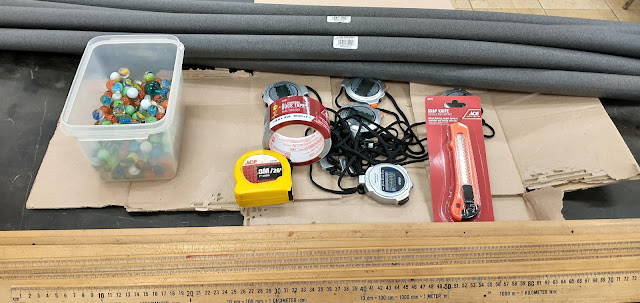Physci exploration: hula hoop rotation rates
Laboratory 14 is a lab practical. The students are given a system where the relationship between the variables is not something available on Google. This term my intent was to have the students look for a relationship between hula hoop diameter and the "natural" rotation rate for the hoop. Unfortunately I could not locate any hoops on island, let along the five different diameters I knew I would need to generate sufficient data points. Lacking any clear idea what might work, would be affordable, and relatively easy to work with, I settled on pipe insulation. This would prove suboptimal being too light to hoop properly.
Equipment included stopwatches, duck tape, meters sticks, a tape measure, a snap knife, and marbles. The marbles could fit in the tubes, but they rolled, so they could not be spaced out to provide a balanced hoop. The marbles were abandoned, but then the hoops were too light.
Pipe insulation details.
Donevan and Melissa
The largest hoop was 120 cm in diameter. The smallest was down around 25 cm in diameter.
Kiora, Nicole, Ilani, and Angelica
The summer session had not included frequency and period in association with laboratory nine, which meant the practical had terminology which was unfamiliar to the students.
Nicole trying to get the 120 cm hoop around. The class, unable to hoop the overly light pipe insulation, used the technique seen here.
Kiora with one of the smaller rings. Background sound is ambient.
The data sets produced negative slopes and data that was arguably reasonably modeled by a linear function over the domain available. That said, I suspect that the hints of curvature are real. A linear model produces a y-intercept that is hard to explain. As the diameter shrinks towards zero the "minimum functional rotation rate" ought to go up without limit until at zero the rate of rotation is effectively infinite. The logarithm function, however, produces a less satisfying result for large diameters. An exponential decay might also be an option.
Over the domain an exponential decay and a logarithmic function fit the data indistinguishably well. Both have their mathematical issues for large hoop sizes. The logarithmic function hits a frequency of zero out at 457 cm. The exponential function says that an infinite diameter hoop can be spun at 0.81 Hz. Removing that constant on the end of the exponential function, however, yields a problematic fit to the data within the range.
Some of the best fits come from hyperbolic inverse functions. To get this level of fit, however, the vertical asymptote has to be offset, which introduces a y-intercept. The frequency does collapse gradually to zero for ever increasing hoop sizes.
That hyperbolic functions of the form y = 1 ÷ x fit well argues that the relationship should be versus one divided by the frequency, which is the period. When the relationship is looked at from a period perspective, linear relationships look more promising,
Here the second set of data not only fits a linear relationship but a zero diameter produces a period very near zero - a result that makes sense. As the diameter increases, the natural rate of rotation increases linearily without limit. Were this lab to be run again I would have the students measure the diameter versus the period, the time for one rotation.
The slopes are small, perhaps shifting to measuring the diameter in meters would help.
Produces a slope that is not quite so numerically small while retaining the same intercept.
Directions on the board were sparse at best. Ultimately the goal is to have the students show that they can arrive at a mathematical model and write up a report on their findings. I rather expect they will settle for a linear regression, which is justified over the data domain.
One student suggested garden hose as that would be heavier, but I think rigidity is a also useful for a true hoop. Ultimately having five different hoop sizes of actual hoops would be optimal.
Thanks go to the one who inspired this laboratory.
















Comments
Post a Comment